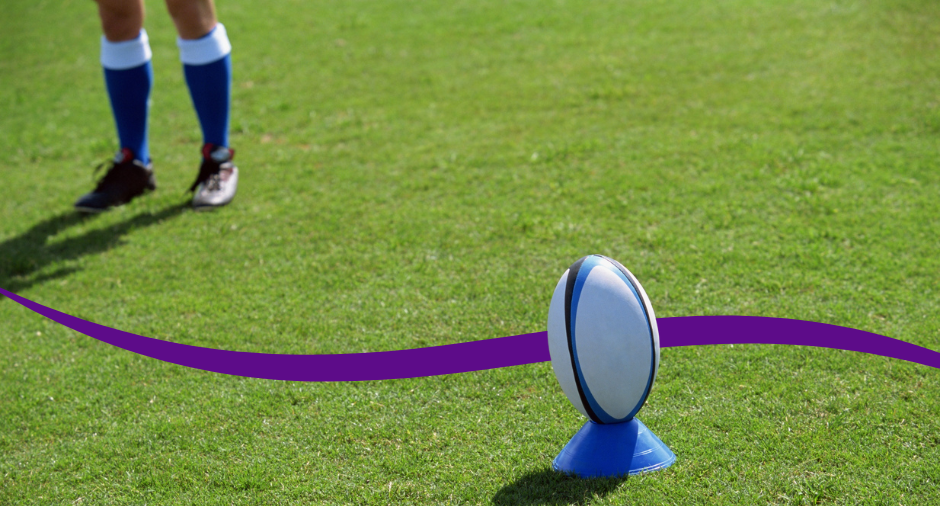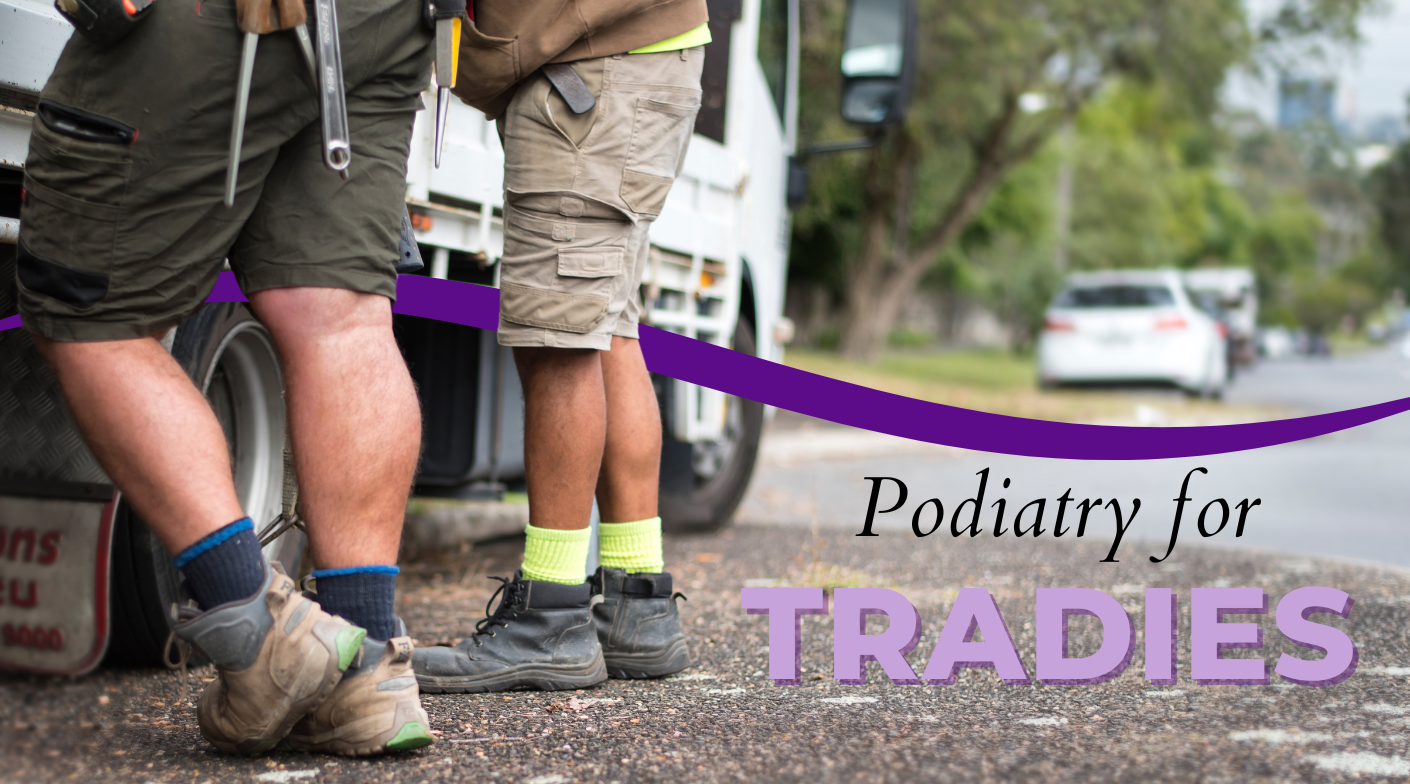

As podiatrists, we see and treat a lot of tradies. Being able to help someone make that transition from working
and walking with foot pain, to being able to stand comfortably on their feet all day without pain or injury, is extremely rewarding for our
podiatrists. With August being Tradies National Health Month here in Australia, we thought we’d share exactly how we work with and
help tradies to not only feel and perform their best at work, but also through every other step so they can truly enjoy their downtime after
all their hard work.

Before we dive in, we thought it may be helpful to clarify exactly what a podiatrist does and is qualified to do. Specifically, that ‘skin and nail care’, which involves trimming toenails and managing corns and calluses and what many people still think of when they think of a podiatrist, is actually a fairly minor part of our role.
Podiatry is the assessment, diagnosis and treatment of a wide range foot, ankle and of lower limb problems. That means we also work with and treat areas like the legs (conditions such as shin splints), and the knees (including patellofemoral pain - “runner’s knee”) too. As being able to move around on your feet, climb stairs or ladders, and keep going for full days is a normal part of the job for many tradies, this makes podiatrists as important to your well-being as a coach is to a rugby team. If you’re a tradie, here’s what your podiatrist wants you to know.
When you’re spending hours on your feet, your bones, muscles and joints are taking on a lot of pressure, which is amplified if the demands of your job involve lifting, bending, squatting or going up and down stairs or ladders.
When any structure in the body is repetitively placed under pressure, it gets overloaded faster than it has a chance to rest and repair, meaning that over time, there’s a notable risk of injury and pain. Unfortunately, if you’ve already developed foot or leg pain or have an existing injury, the nature of the job for tradies makes it less likely that it’ll get better on its own because instead of having downtime to rest and recover, you’re loading and using those damaged muscles, tendons or bones every day that you’re at work. This is where your podiatrist comes in. They’ll create a treatment plan that is tailored to both your unique lower limb biomechanics - and the nature of the work you’re doing. And don’t worry - we understand that for most people, working and staying on your feet is non-negotiable. So our goal will be to keep you at work comfortably, while alleviating pain and helping put the right measures in place for effective healing and repair. We also make sure to address any underlying causes of your pain and discomfort, so you don’t have to put up with the problem over and over again.
To clarify, if you think you’re less vulnerable to foot pain or injury because your particular role involves standing in one place as opposed to moving and climbing stairs throughout the day, think again. When you’re standing all day, you’re consistently loading the same muscles and bones with your body weight and pressure, which can lead to significant discomfort and strain.
Unlike walking or moving, where your weight shifts between different muscles and joints, standing in one place puts continuous stress on specific parts of your feet and legs. This constant pressure can cause muscle fatigue, reduced blood flow, and increased risk of pain and injury, making standing all day just as challenging, if not more so, than more dynamic activities. This makes you vulnerable to overloading specific muscles and developing specific problems, including heel pain (plantar fasciitis), Achilles pain, corns and calluses, and shin splints, to name a few.
When it comes to overuse injuries, which is the most common type we see in tradies due to the repetitive nature of the work, the damage to your muscles, tissues or bones is cumulative. This means that it starts small, like micro-tears starting in a muscle which you likely won’t even feel at the time (other than perhaps some general tired aching), and when the problem isn’t addressed or treated, it worsens over time.
This means that by the time you’re experiencing symptoms like niggles, notable discomforts, or minor pains, they’ll be on the road to worsening and becoming more serious. Podiatrists help you identify your risks - as well as what’s happening with your feet and legs and why any symptoms are presenting - and help prevent your discomfort from turning into a serious problem. A common example is plantar fasciitis - which starts as damage to the fascia and while it may be minor at first, it can progress to a very painful tear without the right treatment.
Just like how an athlete needs to work with someone that understands the unique needs that their chosen sport places on their body, our biomechanical knowledge and experience means that we understand the demands that your work places on your feet and legs. From the reason that your legs ache and feel heavy at the end of the day, to the impact that your heavy work boots are having on your foot pain - we’ve seen and helped with it all - and it’s always a pleasure to do so because of the big difference it makes.
Our comprehensive biomechanical knowledge enables us to help prevent pain and injuries - as well as treat them when they develop. That’s why we start everyone experiencing foot or leg pain with a biomechanical assessment, as it gives us the complete picture of what’s going on and why. We take into consideration the risks of your specific role, and combine these with your foot type and gait characteristics. In most cases, this gives us a precise answer about the symptoms you’re experiencing and why they’ve presented now. This gives us the perfect base to create an effective treatment plan to help you manage the day-to-day risks on your feet, treat existing injuries, and help avoid future injury.
We know that some people may think that foot or leg pain is just a normal part of the job when you’re on your feet all day - but the reality is that it’s not. It’s your body telling you that something isn’t working quite right and changes can be made. The problems and pains that develop at work don’t just stay at work, either. They impact you when you get home, when you’re out with your family, when you’re playing social sports - and everywhere else. That’s why getting your pain treated early is so important/
Here at The Feet People in Brisbane, our podiatrists have dedicated their careers to helping people get the best outcomes for their foot and leg problems, and have plenty of experience in helping tradies with concerns and problems just like yours.
Book your appointment with our podiatry team online here or call us on (07) 3356 3579.
| Monday | 7:40am - 6:00pm |
| Tuesday | 7:40am - 6:00pm |
| Wednesday | 7:40am - 6:00pm |
| Thursday |
7:40am - 6:00pm |
| Friday | 7:40am - 2:00pm |
| Saturday | CLOSED |
| Sunday | CLOSED |
Ground Floor, 344 Queen Street,
Brisbane City QLD 4000
| Monday | 7:40am - 6:00pm |
| Tuesday | 7:40am - 6:00pm |
| Wednesday | 7:40am - 6:00pm |
| Thursday |
7:40am - 6:30pm |
| Friday | 7:40am - 5:00pm |
| Saturday | 7:40am - 4:30pm |
| Sunday | CLOSED |
Newmarket Village, 114/400 Newmarket Rd, Newmarket QLD 4051